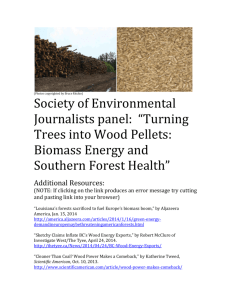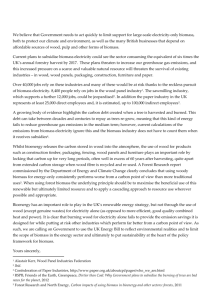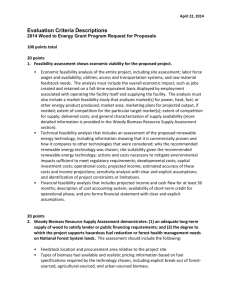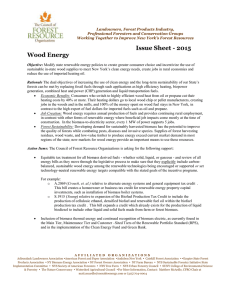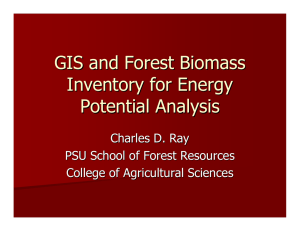PNW Bioenergy From Forests: The Power Potential of Woody Biomass F
advertisement
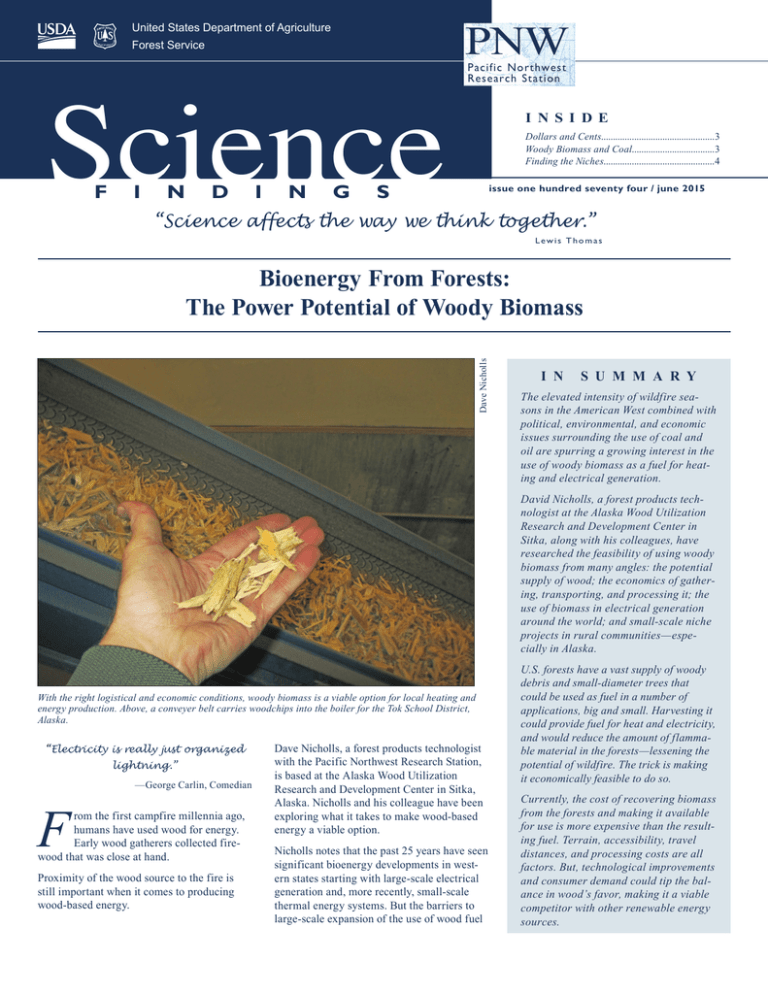
PNW TU DE PA RE United States Department of Agriculture RT MENT OF AGRI C U L Forest Service Pacific Northwest Research Station I nsi d e Dollars and Cents................................................3 Woody Biomass and Coal...................................3 Finding the Niches...............................................4 F I N D I N G S issue one hundred seventy four / june 2015 “Science affects the way we think together.” Lewis Thomas Dave Nicholls Bioenergy From Forests: The Power Potential of Woody Biomass I N S U M M A R Y The elevated intensity of wildfire seasons in the American West combined with political, environmental, and economic issues surrounding the use of coal and oil are spurring a growing interest in the use of woody biomass as a fuel for heating and electrical generation. David Nicholls, a forest products technologist at the Alaska Wood Utilization Research and Development Center in Sitka, along with his colleagues, have researched the feasibility of using woody biomass from many angles: the potential supply of wood; the economics of gathering, transporting, and processing it; the use of biomass in electrical generation around the world; and small-scale niche projects in rural communities—especially in Alaska. With the right logistical and economic conditions, woody biomass is a viable option for local heating and energy production. Above, a conveyer belt carries woodchips into the boiler for the Tok School District, Alaska. “Electricity is really just organized lightning.” —George Carlin, Comedian F rom the first campfire millennia ago, humans have used wood for energy. Early wood gatherers collected firewood that was close at hand. Proximity of the wood source to the fire is still important when it comes to producing wood-based energy. Dave Nicholls, a forest products technologist with the Pacific Northwest Research Station, is based at the Alaska Wood Utilization Research and Development Center in Sitka, Alaska. Nicholls and his colleague have been exploring what it takes to make wood-based energy a viable option. Nicholls notes that the past 25 years have seen significant bioenergy developments in western states starting with large-scale electrical generation and, more recently, small-scale thermal energy systems. But the barriers to large-scale expansion of the use of wood fuel U.S. forests have a vast supply of woody debris and small-diameter trees that could be used as fuel in a number of applications, big and small. Harvesting it could provide fuel for heat and electricity, and would reduce the amount of flammable material in the forests—lessening the potential of wildfire. The trick is making it economically feasible to do so. Currently, the cost of recovering biomass from the forests and making it available for use is more expensive than the resulting fuel. Terrain, accessibility, travel distances, and processing costs are all factors. But, technological improvements and consumer demand could tip the balance in wood’s favor, making it a viable competitor with other renewable energy sources. are significant, and the price of nonbiomass renewable energy (including solar, wind, and geothermal) are generally lower than the cost of biomass energy systems. “However, in the big picture, biomass is a golden opportunity to reduce greenhouse gasses and our global carbon emissions,” says Nicholls. This interest in wood-based energy is driven by several factors. Fire seasons are getting longer and more extreme. This change is driven by drought, insect outbreaks that have left millions of acres of dead or dying trees across the West, and past management practices such as fire exclusion which has resulted in the accumulation of forest fuels. The opportunist sees the biomass potential in these trees too small to be used for traditional wood products: woody biomass that could be used to generate energy. KEY FINDINGS • Across the western United States, the value of woody biomass products will rarely pay for the costs of harvesting, collecting, and transporting woody biomass to markets. Niche opportunities exist, however. • Cofiring coal and biomass to produce electrical energy is a viable option for U.S. power producers. Opportunities exist for smaller facilities to be converted entirely from coal to wood or other biomass fuels. • Over the past decade, Alaska has seen significant growth in the use of wood for energy as well as the number of facilities heating with wood. More than 20 schools, forest products producers, or government agencies are using wood heating systems in Alaska. • The use of wood energy has enabled rural communities to become more self-sufficient while reducing energy costs. Cost of alternative fuels such as heating oil was a primary factor in influencing the switch to wood energy. • Bioenergy is more commonly used in Europe than in the United States. Much could be learned by examining the policies and technology that have facilitated its use. Rhonda Mazza In the early 2000s, two national efforts emerged that have driven interest in using woody biomass from federal forests to produce electricity. The first was the National Fire Plan, initiated in 2000. Goals of the plan include helping at-risk communities prepare for wildfire seasons and managing the landscape to be resilient to fire. An essential part of that is reducing the amount of forest fuel— often characterized by high densities of small trees that have little or no value for solid wood products—in the immediate vicinity of those communities. Purpose of PNW Science Findings To provide scientific information to people who make and influence decisions about managing land. PNW Science Findings is published monthly by: Pacific Northwest Research Station USDA Forest Service P.O. Box 3890 Portland, Oregon 97208 Factors that influence the feasibility of biomass wood energy include price of delivered biomass, diesel fuel cost, and transportation distances. Above, a recently thinned stand. Send new subscriptions and change of address information to: pnw_pnwpubs@fs.fed.us Rhonda Mazza, editor; rmazza@fs.fed.us Cheryl Jennings, layout; cjennings@fs.fed.us Science Findings is online at: http://www. fs.fed.us/pnw/publications/scifi.shtml To receive this publication electronically, change your delivery preference here: http://www.fs.fed.us/pnw/publications/subscription. shmtl United States Department of Agriculture Forest Service Three years later, the Healthy Forest Restoration Act of 2003 was passed, which aimed to improve the health of forests stands overcrowded with small trees and thus more susceptible to insects, disease, and wildfire. From 2001 through 2008, more than 29 million acres of federal land were treated to reduce the amount of fuels. Also in 2003, the U.S. Departments of Agriculture, Energy, and the Interior announced an initiative to encourage the use of woody biomass from forest and rangeland restoration and hazardous fuels treatment projects. The “Billion Ton” study, a joint study by the Forest Service and Department of Energy was launched in 2005. The study’s purpose was to see if the United States could sustainably replace 30 percent or more of its domestic petroleum consumption with biofuels—including wood and other agricultural products. It estimated that forest lands could produce 368 million oven-dry tons per year. Other national efforts such as the National Cohesive Strategy and the USDA’s Biomass Crop Assistance Program authorized by the 2014 Farm Bill continue to bolster the biomass movement. The Biomass Crop Assistance Program, for example, helps eligible farmers, ranchers, and foresters offset the cost of delivering agricultural or forest residues to qualified energy facilities. 2 DOLLA RS A N D CENTS C alifornia in the 1980s pioneered the development of stand-alone biomass electrical plants. They were relatively large by bioenergy standards, Nicholls explains, with generation capacities up to about 50 megawatts, and used a variety of fuels, including wood and agricultural residues. At full capacity, they could supply about 2 percent of California’s peak electrical needs. But in the 1990s, the California Public Utilities Commission restructured the state’s electric industry. This reduced subsidies for biomass. As a result, some bioenergy facilities closed after just a few years of operation, resulting in a modest loss reduction of generating capacity. More importantly, it undermined the nascent infrastructure that harvested, processed, and transported biomass fuel. “This points to the need for a long-term policy approach for developing bioenergy projects so that facilities are able to weather short-term variations in fuel prices and other economic uncertainties,” Nicholls says. To be successful, bioenergy projects need a reliable and long-lasting supply of fuel, effective transportation networks, fuel handling equipment, and combustion or gasification equipment to convert wood energy to a usable form. Power plants are often expected to operate at least 20 years, so the companies that build them want assurance that they’ll have a steady source of fuel for that period. But even though forests produce a seemingly unlimited supply of woody fuel, the cost of getting it to power plants can be huge. In fact, Nicholls says, “Rarely will the value of biomass products pay for the costs of harvesting, collecting, and transporting to markets in the western states.” The economic feasibility of thinning smalldiameter trees and other woody fuel from the forest is very site-specific. Generally, the steeper the slope, the more expensive treatment becomes. Total costs can vary from $35 to more than $1,000 per acre depending on terrain, number of trees to be treated and the size of stems to be removed, among other factors. Nicholls says the average cost to thin small-diameter and underutilized woody material is typically about $70 per oven-dry ton—or roughly twice the price historically paid by energy and chip markets for wood waste. The wood products industry has been a source of chips and sawdust that can be used for bioenergy. But mills have become more efficient as the availability of regional timber has declined, and fewer mills are accounting for a larger portion of the mill residue supply. Nicholls notes that in many western states sawmill residues are already almost fully utilized in kiln-drying lumber, manufacturing wood pellets and other uses, leaving little to contribute to a developing bioenergy industry. More than 28 million accessible acres of forest in the West could benefit from hazardous fuel removals, a process that could yield 345 million oven-dry tons of material, Nicholls and his colleagues report in their synthesis of biomass utilization for bioenergy production in the western United States. Where communities are at risk, incentives are already in place for quickly harvesting and removing woody biomass. The challenge for natural resource managers is to find markets and products that recover at least a portion of the costs of treatment. WOODY BIOM ASS A N D COA L carbon dioxide emissions from coal-burning facilities,” Nicholls says. Dave Nicholls Coal is still a significant energy source in the United States. We use more than a billion tons per year, and about 93 percent of that is used by the electric power industry, according to the U.S. Energy Information Administration. Nicholls and a colleague recently evaluated the status, trends, and barriers to cofiring. “Cofiring with woody biomass could significantly reduce the use of fossil fuels in energy production in the United States, and cut greenhouse gas emissions,” explains Nicholls. “Cofiring with biomass and coal is a simple mixing process. It is proven, off-the-shelf, inexpensive technology that would require little change in existing infrastructure,” he says. “It has been estimated that if all coal plants in the state of Colorado cofired at even Wood and coal travel together along the conveyor belt at Aurora Power, during a cofire test burn in Fairbanks, Alaska. Dave Nicholls W ood can be used as the sole source of fuel to produce electricity or heat, but it can also be mixed with coal. Cofiring, as it’s called, burns biomass (woody, agricultural, or urban waste) with coal to produce electricity using existing coalfired boilers. As a supplement to coal, biomass may lower fuel costs and reduce emissions of sulfur dioxide and nitrogen oxides. “It is perhaps the best short-term means for reducing With the high cost of heating oil and an abundance of nearby wood, many Alaska communities are developing wood-based energy sources. Above, a roadside wood pile near Tok, Alaska, that will be chipped and used to heat the local school. 3 a rate of 1 percent, it would add 53 megawatts of wood energy capacity. That’s about the size of a large wood energy installation.” biomass and ratio of the mixture are variables that determine the threshold between levels of capital investment needed to cofire. Nicholls’ report documents the different cofiring trials that coal facilities have conducted around the country. The size and type of In March 2015, Nicholls, collaborator Daisy Huang and other colleagues from the University of Alaska-Fairbanks conducted cofiring test burns at a utility in downtown Fairbanks. This trial, the first of its kind in more than 30 years, demonstrated the feasibility of burning coal and wood at levels of up to 15 percent. It also opened the door for future tests using low-grade wood wastes. FI N DI NG TH E N ICH ES In many rural areas across the western United States and Alaska, it’s becoming more commonplace for schools to use woody biomass to generate heat. The pilot Schools for Fuels program, initiated in 2003 in Montana, worked in partnership among the participating school districts, the community, and local nongovernment organizations. The program’s goal was to demonstrate that chipped wood or wood pellets were the most economical and efficient form of heating energy for those areas. “Although school heating systems use relatively small amounts of biomass, typically on the order of a thousand green tons or less per year, they have strong potential applications in western states because they are often motivated by hazardous fuel removals adjacent to at-risk communities,” Nicholls says. Lessons learned from the Fuels for Schools program are being applied to several school systems in Alaska. In Tok, for example, hazardous fuels have been removed to reduce Dave Nicholls Dave Nicholls W oody biomass is used economically as a source of heat and electrical power in other parts of the world. Several countries in Europe–notably Finland, Sweden, Austria, and The Netherlands—use biomass for electrical generation, including cofiring with coal, at a higher proportion than the United States. Government taxes on energy and carbon dioxide emissions have made biomass in those countries competitive with fossil fuels. The wood chip boiler at Delta Junction School, Alaska. Dan Bihn The wood storage facility in Tok, Alaska. community fire risk. In a process called cogeneration, biomass is being used to generate both electricity as well as heat, which is used for school buildings and a greenhouse on campus. In Alaska, several new wood energy installations have come online in the past few years, providing heat to school buildings and community centers. In 2010, the state’s first large-scale pellet boiler was installed by the Sealaska Corporation at its corporate headquarters in Juneau. That same year, the Tok School installed a chip-fired boiler that displaces approximately 65,000 gallons of fuel oil annually. Other wood-fired boilers have been installed in Coffman Cove, Craig, Dot Lake, Gulkana, Kasilof, and Tanana. Hydronic heating from the wood-energy system heats the soil to the desired temperature. Students from the Tok School District, Alaska, work in the greenhouse, which is yielding fresh local produce. In rural Alaska where heating fuel is sometimes delivered by air or by long-distance water transport, there’s a desire for a less costly option. Through Alaska Energy Authority, more than 20 wood heating systems are now operational and reducing heating costs in Alaska communities. The state’s Renewable Energy Fund grants program has funded 34 biomass projects, and others are in development. Biomass projects can lead to economic development. “In rural Alaska, every job counts, whether it’s splitting wood or stoking the boiler,” says Nicholls. 4 The Community Biomass Handbook Volume 1: Thermal Wood Energy developed by the Forest Service, the University of Minnesota, and Bihn Systems LLC was created to help users identify the niches where wood-based energy makes sense. The handbook, published electronically as an iBook and available as a .pdf, includes a financial calculator that with just a few inputs, allows users to estimate the capital investment and operations costs, biomass requirements, and return on investment. It helps users quickly determine the technical and financial feasibility of potential biomass energy projects. Eini Lowell, the Forest Service lead on the project explains, “We got the idea for the handbook because we noticed communities were spending so much money on feasibility studies, and that if proposed projects didn’t pan out, they didn’t have enough money left to explore other options.” It was designed to be used by local and regional economic development agencies, local businesses, school districts, city planners, and state and federal forest management agencies. Volume 1 of the handbook, released in 2014, was designed primarily for the lower 48 states. Volume 2 is expected to be released L A N D M A NAG E M E N T I M PL ICAT ION S • Wood-to-energy programs have numerous benefits. They reduce the use of fossil fuels during production of electricity, thermal energy, and liquid fuels; and help diversify the economies of many rural communities. When logistically feasible, they can reduce the costs of forest restoration and fuel reduction activities. • Biomass may be used to produce energy at various scales, from electrical power generation at stand-alone facilities to heating governmental, educational, or other institutional buildings. • State and federal governments have a large role to play as catalysts in stimulating new technologies and new uses of biomass material. in summer 2015. It is designed to increase its range of usability, particularly in Alaska, and illustrates examples of biomass heating in Alaskan communities. “The financial application has been updated so that it will now work better for Alaska” says Lowell. “It includes a cord wood boiler option, which the first version didn’t, allows you to input higher fuel costs, reflective of actual costs in Alaska, and includes geographic location to capture heating degree day data. This was done to provide better estimates for sizing a potential boiler.” Wood-based energy isn’t a panacea, but in niche locations, it can lead to numerous benefits, including lower energy costs, reduced greenhouse gas emissions, and improved greater forest health in areas surrounding the community. “An old thing becomes new if you detach it from what usually surrounds it.” —Robert Bresson, French film director FOR FU RT H ER R EA DI NG Becker, D.; Lowell, E.; Bihn, D.; Anderson, R.; Taff, S. 2014. Community biomass handbook. Volume I: thermal wood energy. Gen. Tech. Rep. PNW-GTR-899. Portland, OR: U.S. Department of Agriculture, Forest Service, Pacific Northwest Research Station. 93 p. http://www.treesearch.fs.fed. us/pubs/45769. Nicholls, D.L.; Monserud, R.A.; Dykstra, D.P. 2008. A synthesis of biomass utilization for bioenergy production in the Western United States. Gen. Tech. Rep. PNWGTR-753. Portland, OR: U.S. Department of Agriculture, Forest Service, Pacific Northwest Research Station. 48 p. http:// www.treesearch.fs.fed.us/pubs/30180. Nicholls, D.L. 2009. Wood energy in Alaska—case study evaluations of selected facilities. Gen. Tech. Rep. PNWGTR-793. Portland, OR: U.S. Department of Agriculture, Forest Service, Pacific Northwest Research Station. 33 p. http:// www.treesearch.fs.fed.us/pubs/33088. Nicholls, D.L.; Monserud, R.; Dykstra, D. 2009. International bioenergy synthesis— lessons learned and opportunities for the western United States. Forest Ecology and Management. 257(8): 1647–1655. http:// www.treesearch.fs.fed.us/pubs/32584. Nicholls, D.L.; Brackley, A.M.; Barber, V. 2010. Wood energy for residential heating in Alaska: current conditions, attitudes, and expected use. Gen. Tech. Rep. PNWGTR-826. Portland, OR: U.S. Department of Agriculture, Forest Service, Pacific Northwest Research Station. 30 p. http:// www.treesearch.fs.fed.us/pubs/35579. Nicholls D.L.; Zerbe J. 2012. Biomass and coal cofiring for fossil fuel reduction and other benefits status of North American facilities in 2010. Gen. Tech. Rep. PNWGTR-867. Portland, OR: U.S. Department of Agriculture, Forest Service, Pacific Northwest Research Station. 22 p. http:// www.treesearch.fs.fed.us/pubs/41436. W R I T E R’ S PRO F I L E John Kirkland has been writing about science, higher education, and business for more than 20 years. He lives in Portland, Oregon. 5 F I N D I N G PRSRT STD US POSTAGE PAID PORTLAND OR PERMIT N0 G-40 S U.S. Department of Agriculture Pacific Northwest Research Station 1220 SW Third Avenue P.O. Box 3890 Portland, OR 97208-3890 Official Business Penalty for Private Use, $300 sci e ntist profil e DAVID NICHOLLS, a research forest products technologist with the USDA Forest Service Pacific Northwest Research Station, is based at the Alaska Wood Utilization Research and Development Center in Sitka, Alaska. He conducts research on a variety of wood products topics of importance to Alaska, including wood residue utilization, residential heating with wood energy, community energy management, wood product carbon balances, and wood products marketing. Nicholl’s received a Ph.D. in wood science and technology from Penn State University, an M.S. in forest products from the University of Minnesota, and a B.S. in forest management from Oregon State University. COLLABOR ATORS Nicholls can be reached at: Alaska Wood Utilization Research and Development Center 204 Siginaka Way Sitka, AK 99835-7316 Phone: (907) 747-4312 E-mail: dlnicholls@fs.fed.us Valerie Barber and Daisy Huang, University of Alaska, Fairbanks, AK Andy Mason, USDA Forest Service, State and Private Forestry, AK John Zerbe, USDA Forest Service, Forest Products Laboratory, WI Allen Brackley, Eini Lowell, Dennis Dykstra (retired), and Robert Monserud (retired), USDA Forest Service Pacific Northwest Research Station The U.S. Department of Agriculture (USDA) prohibits discrimination in all its programs and activities on the basis of race, color, national origin, age, disability, and where applicable, sex, marital status, familial status, parental status, religion, sexual orientation, genetic information, political beliefs, reprisal, or because all or part of an individual’s income is derived from any public assistance program. (Not all prohibited bases apply to all programs.) Persons with disabilities who require alternative means for communication of program information (Braille, large print, audiotape, etc.) should contact USDA’s TARGET Center at (202) 720-2600 (voice and TDD). To file a complaint of discrimination, write USDA, Director, Office of Civil Rights, 1400 Independence Avenue, SW, Washington, DC 20250-9410 or call (800) 795-3272 (voice) or (202) 720-6382 (TDD). USDA is an equal opportunity provider and employer.
